Blog
Tipsy M5 Review — Headfonics

Marcelo reviews the Tipsy M5, a new hybrid IEM featuring a single 8mm dynamic driver, 2 BA drivers, a planar, and bone conduction drivers. It is currently priced at $399 and due to be launched on Nov 11th, 2025.
Disclaimer: This sample was sent to me in exchange for my honest opinion. Headfonics is an independent website with no affiliate links. I thank Tipsy Audio for their support.
You can read about previous Tipsy products previously reviewed on Headfonics here.
This article follows our latest scoring guidelines, which you can read here.
Tipsy Audio was established in 2016, serving the professional market, and aiming to recreate a studio-quality sound inspired by the Shenzhen Concert Hall.
Following on from my recently reviewed hybrid V-shaped M3 IEM, I now have the new $399 Tipsy M5, launching in a matter of days.
This is a new five-unit hybrid with four driver technologies, tuned as a reference-level monitoring earphone with bone-conduction enhancement.
Will the Tipsy M5 really deliver on its promise? Or how will it compare to more consumer-oriented hybrid IEMs such as Kiwi Ears Astral and Kinera NOTT Phantom? Let’s find out.
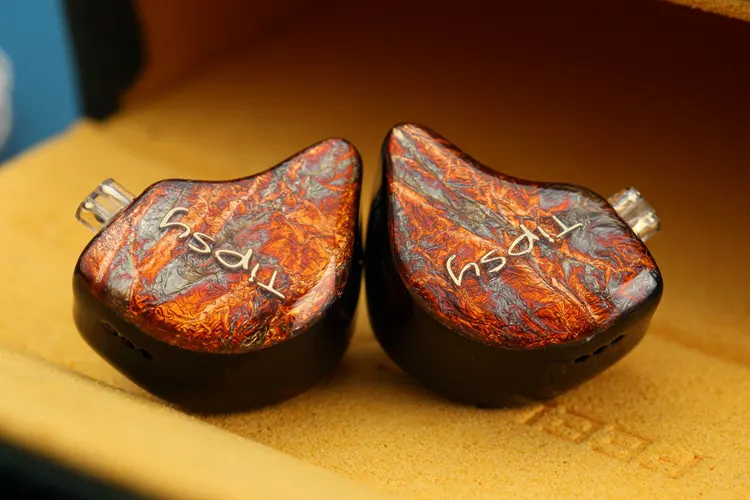

Features
The Tipsy M5 is an excitingly configured IEM with its quadbrid configuration consisting of 1 x 10mm bone conduction driver, 1 x 8mm PU+DLC composite dynamic driver, 2 x custom balanced armature drivers, and 1 x planar speaker unit.
The tuning style is reference level monitoring type, which means the perceived frequency response is flat and the tonality is neutral. Audio frequencies are divided by a four-way crossover, and sensitivity is rated at 109 dB/mW with an impedance of 20Ω.
The M5 also features a pressure relief system to alleviate pressure build-up in the ear canal, which can cause pain in the ears, nausea, and headaches.
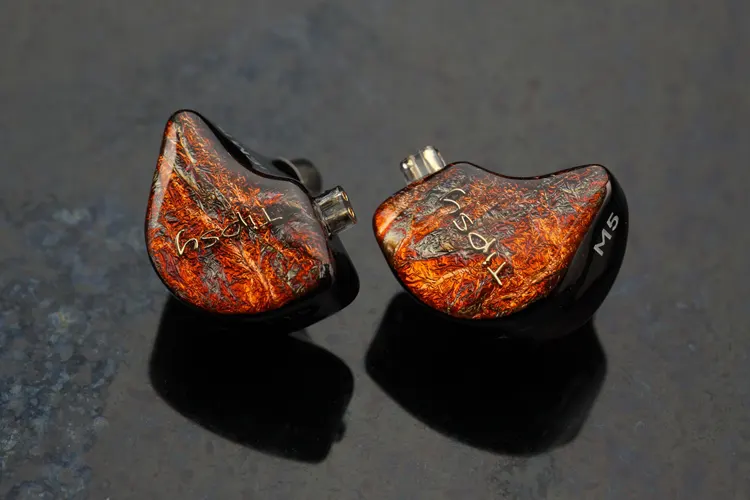

Design
All those drivers and crossover parts are housed in a black 3D printed resin shell, which is medium in size but very light in weight at only 5.3 grams. The M5 face plate has a complex, deep orange pattern that is difficult to understand but beautiful to look at.
The nozzle is metal and looks good; unfortunately, there is no lip on the outside, making some ear tips easy to lose. There are three vent holes on the side near the QDC style 2-pin connector.
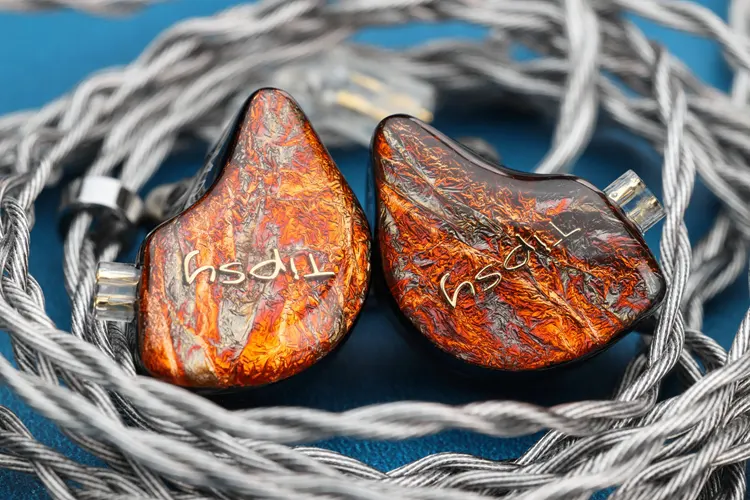

Stock Cable
The Tipsy M5’s included cable is thin enough for easy portability but thick enough not to tangle easily. It is a grey-colored 4-core cable with a 1.1mm thickness per wire, terminated in a fixed 3.5mm plug and QDC-style IEM connectors.
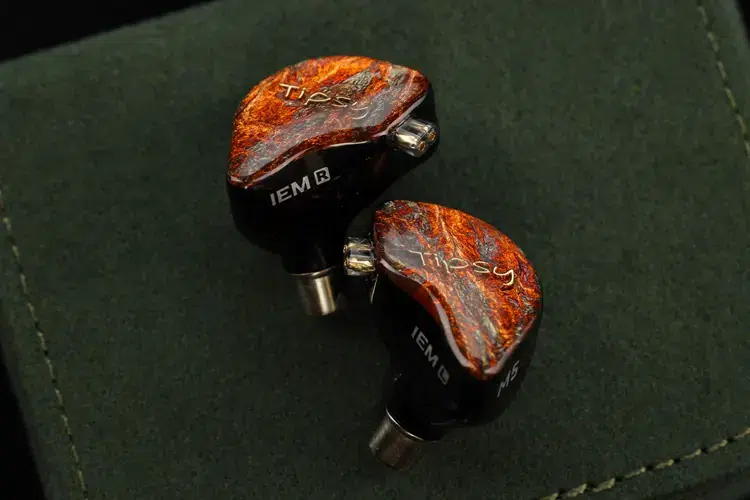

Comfort & Isolation
Thanks to its ergonomic shape, moderate size, and light weight, plus the effective pressure relief system, the M5 is very comfortable to wear, even during long listening sessions, anytime, anywhere, without any pressure build-up or discomfort due to weight.
Isolation is the same as any IEMs with a pressure relief system; some sound gets in, but they are easily masked by the music being played at a moderate volume level.
Packaging & Accessories
My Tipsy M5 review sample didn’t come with official packaging, as this is a pre-release product.
I was sent a soft copy of the tech specs and a list of included accessories, which consists of the 1.2m 3.5mm cable, one pair of slow rebound memory foam ear tips, three pairs of liquid silicone ear tips, three pairs of black silicone balance ear tips, and a green suede leather storage case.
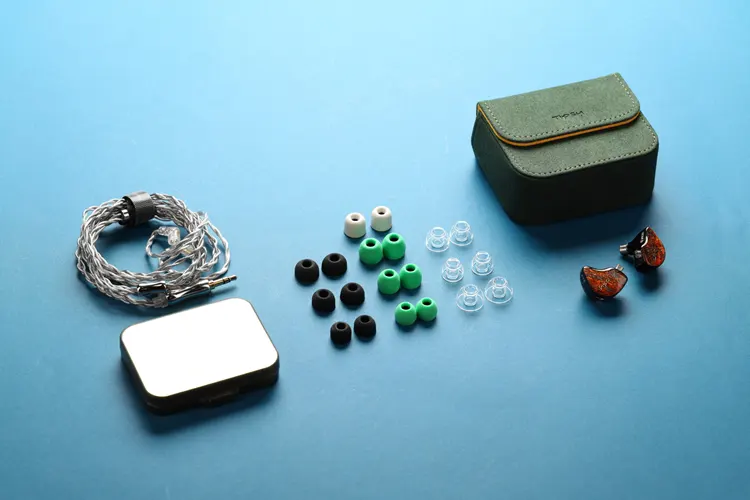

Sound Impressions
I did my standard 24-hour burn-in, but still felt it needed more burn-in as it was lean-sounding at first, so I left it burning in for another 24 hours or more. This resulted in a denser and more energetic bass, smoother treble, and coherent sound.
For the sources, I used my iBasso DC-Elite, MUSE HiFi M5 Ultra DAC amplifiers, using my Android phone, OnePlus 13, as the music transport, and the FiiO M15S DAP, using either UAPP or Poweramp music player App.
I used the clear silicone ear tips because I find them to be the most open-sounding and have the most impressive soundstage. I find the black-silicone ear tips slightly dark-sounding, and I don’t like using foam tips, regardless of sound quality.
I used a third-party 4.4mm balanced cable with QDC connectors to get the most power from the sources and for equality during sound comparison with other IEMs.
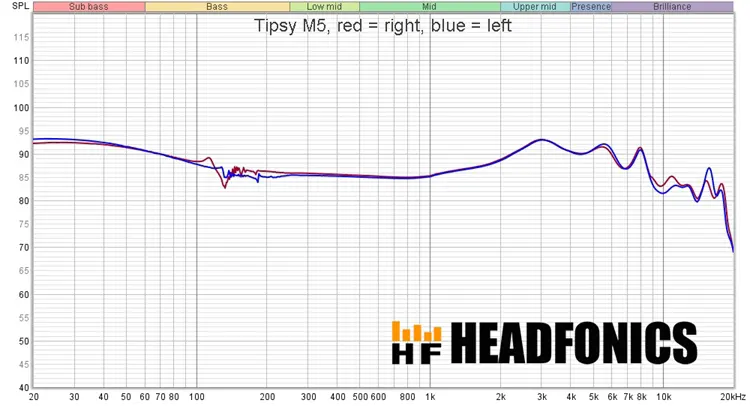

Measurements
My Tipsy Audio M5 measurement reveals an excellent left and right channel matching, indicating a high level of manufacturing quality.
There is a moderate boost in response in the sub-bass and upper midrange, and the upper treble is very extended, indicating a reference-level monitoring type tuning.
The grasses between 100Hz and 200Hz are caused by the bone conduction drivers interacting with the shell, ear tips, and measuring tool, and there is no audible anomaly in that frequency range during listening.
The 8 kHz peak is a measurement artifact as well and is not perceived as such.
Summary
Some might think that achieving a flat perceived, reference-level monitoring response target is easy.
Still, it is actually more challenging than completing a V-shape, U-shape, or W-shape, as it requires more precise adjustments of the drivers to achieve it, which is also the reason why many IEMs claim to do so but rarely achieve it.
That said, I can vouch for Tipsy’s claim of reference-level monitoring tuning for the M5, as I find its bass, lower mids, upper mids, highs, and ultra-highs to be equally and accurately represented.
Bass is tight, deep, and fast, with good density and detail, thanks to Tipsy’s exemplary implementation of bone conduction drivers, which add a natural-sounding density to the bass and lower mids without introducing any coloration or slowing down the sound.
Midrange and upper midrange are perfectly balanced by having both presence and body or note weight on the vocals and instruments.
Treble is open-sounding with a lot of details yet never sounding harsh or piercing, and the upper treble is very airy and extended with gentleness in expression that I associate with good planar implementation.
Coloration
The M5 is one of the least colored IEMs I have tried, as there is no warming or thinning of sound, no shoutiness in the upper midrange, and no peakiness or artificial sharpness in the treble.
Even the bone conduction drivers don’t add coloration; I only hear the enhancement they bring to the sound. However, I have never tried an IEM that has absolutely no coloration, and even though the M5 is transparent, it is no exception.
I can hear a slight excess in energy above 10 kHz, and the mild peak at 5.5 kHz, which also shows up in the measurement.
However, these excesses are benign; they only add excitement and liveliness to the sound, which prevents M5’s neutral, reference-level monitoring tuning from sounding dull.


Soundstage
Thanks to M5’s superb bass and treble extension, balanced midrange, and clean background decay, Soundstage is very spacious with a natural, wide-open feeling.
Soundstage shape is slightly wider than it is deep, with remarkable height. There is excellent lateral broadness where the left and right images are coming from, and the lateral panning is seamless and never loses definition as they move along.
The separation between the instruments is good as the edges of the images are well defined.
Front-to-back layering is good as well, and I can clearly hear the main vocalist in front with the well-separated background instruments behind the singer; there is also good ambience rendition behind my head.
Dynamics
There is never a dull moment with the M5. It bubbles with energy and enthusiasm from sub-bass to the ultra-high frequencies.
The M5 is energetic whether listening at low, medium, or high volumes. It is easy to drive, so even low-powered small dongle DACs can drive it to high volume levels, albeit not ideal due to the sound quality limitations of such DACs.
The M5 dynamics are very good and can take a lot of power from the source. It can go to deafeningly loud volume levels without distorting or going into dynamic compression.
The M5 never caused any noise in all the sources I paired it with; the cable picked up no radio frequency interference, and the M5 is not sensitive enough for me to hear the noise floor of the sources being used.
Click on page 2 below for my recommended pairings and selected comparisons.













